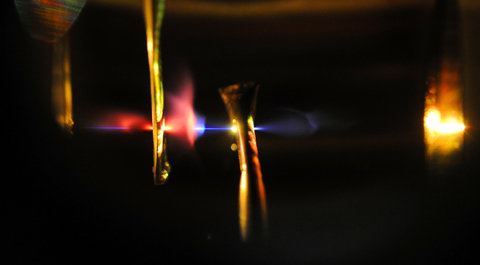Insight into Attosecond Physics
The new homepage of the Laboratory for Attosecond Physics at MPQ, Garching and Ludwig Maximilians Universität München gives an insight into their research on ultrafast processes in nature.
Anyone delving deep into matter must reckon with the fact that the usual time scales cease to be valid in the tiny dimensions of molecules, atoms and electrons. Molecules react within femtoseconds (millionths of a billionth of a second). The motion of electrons in atoms is a thousand times faster still, lasting just a few attoseconds. The Laboratory for Attosecond Physics (LAP) team, headed by Prof. Ferenc Krausz, at Max Planck Institute of Quantum Optics in Garching and Ludwig Maximilian’s University of Munich are conducting research on these ultrafast processes by means of ultrashort light flashes. The physicists involved now present a new homepage (www.attoworld.de) that gives a broad view of their work, and explain to both the lay public and experts how they coax the microcosm into divulging its secrets.
Welcome to the dashing world of quanta. The new homepage www.attoworld.de in English is all about ultrafast motion and minute time dimensions. Due prominence is given to the fascinating interaction of electrons and light pulses.
The light pulses, produced with the most modern lasers, last just a few femtoseconds to attoseconds (an attosecond being a billionth of a billionth of a second). They allow the LAP scientists to photograph, so to speak, quantum particles and thus gain insight into the fundamental processes of life. Attosecond Physics also affords promising prospects in technology, for light waves and the electric and magnetic fields involved make it possible not only to observe, but also to control electrons. This opens the way to completely new applications, such as in information technology.
The new attoworld homepage now shows in detail how these ultrafast processes are being investigated. The scientific information provided is aimed at both the interested lay public and fellow scientists. After a personal introduction, the LAP team gives information on how to become a laser physicist, what constitutes a scientist’s work and what fascinates each of them about attosecond technology.
In recent years attosecond physics has undergone enormous development. This is impressively testified to by the increasing number of renowned publications. The attoworld homepage now aims to accompany this fascinating area of physics with current articles, illustrations and photos. Regular clicking is always worthwhile. Thorsten Naeser

Description for illustration:
View into a vacuum chamber where attosecond light pulses are generated. Picture credit: Thorsten Naeser
Further information available from:
Thorsten Naeser
Max Planck Institute of Quantum Optics
Laboratory for Attosecond Physics
(Professor Ferenc Krausz)
Hans-Kopfermann-Str. 1, 85748 Garching
Phone: + 49 (0)89 / 32905 -124
E-mail: thorsten.naeser@mpq.mpg.de
Dr. Christian Hackenberger
Ludwig Maximilians Universität München
Laboratory for Attosecond Physics
(Professor Ferenc Krausz)
Hans-Kopfermann-Str. 1, 85748 Garching
Phone: + 49 (0)89 / 32905 -622
E-mail: christian.hackenberger@mpq.mpg.de
